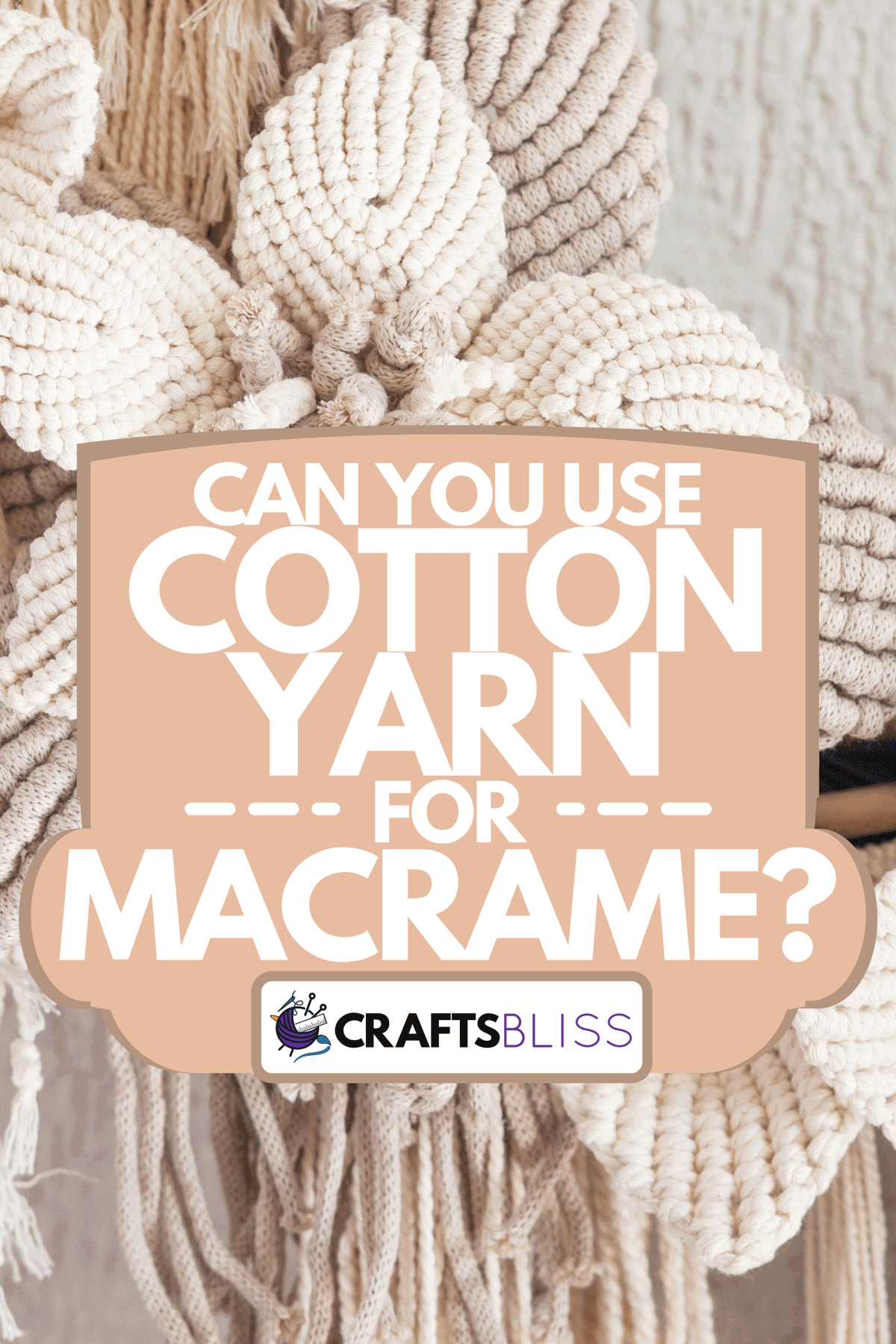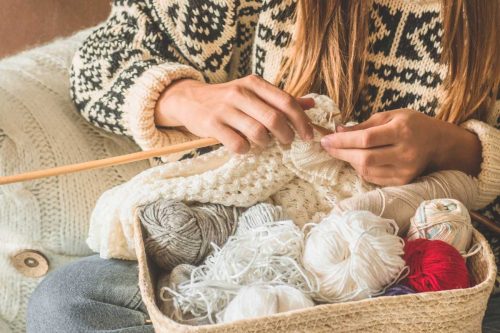Macrame is a creative way to use knots decoratively to create elaborate wall hangings, jewelry, and home decor. However, you may be questioning if you can use cotton yarn to make macrame pieces? We researched the common types of cords and yarns used to make macrame and what experts had to suggest. Check out how and if you can use cotton yarn to make macrame creations to share and show off.
Typically, macrame is created using thick cording made from hemp, cotton, and other natural or synthetic fibers. If you are short on macrame cord, it is possible to use a thicker cotton yarn with a higher ply to create macrame.
Love the rising trend in creating beautiful macrame and want to use cotton yarn? Keep reading to learn more about using this reliable fiber for crafting.

Making Macrame With Cotton
Most cords for making macrame are from natural fibers such as jute, linen, hemp, cotton, and wool. So, creating a macrame wall hanging or other decorative pieces with cotton yarn is feasible. When creating macrame, cord, twine, or yarn is knotted into eye-catching patterns using a series of half-hitch knots and square knots. Beads may be added in open areas lacking knots. It is possible to create intricate and beautiful macrame purses, jewelry, and basic apparel using cotton yarn.
Choose rope, cording, yarn, or twine made from an inexpensive material like cotton or synthetics when first starting to learn macrame. If you desire to create a collar, bracelet, or earrings requiring fine, tiny knots, it is okay to work with delicate cotton thread or yarn.
Be mindful that using crochet or knitting yarn has a lot more squish and flexibility than the average macrame yarn or twine made from thicker strands of cotton, hemp, or jute. Have fun experimenting with different outcomes to discover which cotton yarn is best for your macrame project.

Versatile Crafting With Cotton
Ideally, it is best to use a thicker cotton cord to create macrame pieces like those often showcased in magazines and look books. However, if you choose to make macrame with cotton crochet thread, this is best for smaller projects like keychains, friendship bracelets, earrings, or a coaster.
Most macrame cord is either single strand, braided, or 3-ply. Embroidery thread is too fine for working macrame, but a good-sized cord or yarn that handles well will work. Look for yarn that is flexible, feels good on the hands when making knots, and is appropriate for the size of the piece you are making.
Check out this natural cotton macrame cord on Amazon.
What Type Of Yarn Is Used For Macrame?
Most yarn for macrame is either natural or synthetic fiber. Macrame can be created using yarn made from polyester and nylon or from hemp, cotton, linen, or jute. Instead of reaching for crochet or knitting yarn, most craft lovers choose macrame cord. Be mindful about how the texture, finish, and feel of your choice of macrame yarn or cord will affect your creation.
There are three sizes of yarn or cord that you will find at craft stores or mass retailers online or offline.
- Small - measures between 1 to 2 mm in diameter and is handy for fine jewelry
- Medium - most common cord with a diameter between 3 to 4 mm, ideal for wall hangings, planters, rugs, etc.
- Large - when you want to work bigger than standard, opt for a diameter of 6 mm for maximum coverage.
Also, keep in mind that most macrame projects are easier to knot when selecting a quality brand of cording that is single strand. You may want to wait to try making knots using a braided cord or 3-ply yarn until you get the hang of things. The ease of finishing macrame pieces, making fringe, creating knots, and working with the rope or cord will vary based on your selection.
Check out this crafty hemp cord on Amazon.
What Is The Best Macrame Yarn?
The best macrame yarn should be strong yet supple enough to handle being knotted into intricate patterns. Macrame yarn may be interchangeably referred to as cord, twine, rope, or threads. However, you can successfully execute a macrame project using crochet or knitting yarn or cotton twine. Choose the best yarn for the craft, whether it is a wall hanging, plant hanger, or bracelets.
Opt for organic cotton twine, natural cotton thread, or organic hemp cord for the most traditional-looking results. Look over the finish, feel, strength, and weight of the macrame yarn before making a final decision. Your choice of macrame yarn should be easy to work with and look good.
Can You Use Yarn For A Macrame Plant Hanger?
The chic bohemian look of macrame is perfect for an earthy plant hanger. If you want to make a smaller plant hanger, think about the proportion of the size of the knots compared to the size of the pot and plant. Create magical airy plant hangers for air plants using a finer cotton yarn, or make a more traditional chunky hanger with thicker cotton twine or rope. If you are in a pinch, consider braiding yarn into thicker strands of equal length to knot into elegant macrame designs.
You can also create a sound, macrame plant hanger using inexpensive cotton twine, 3-ply yarn, or a braided strand for extra strength. Play around with open work designs and stick to four main knotted strands. These strands should connect and the main point where the plant hangs for necessary support.
Check out this macrame plant hanger kit on Amazon.
How Much Yarn Is Needed For A Macrame Plant Hanger?
For a simple, open-work macrame plant hanger, you can use eight strands of yarn that measure 94 inches in length. Take the yarn, fold it half-wise and make a knot. Take the loop and attach it to a fixed area, so it is easier to knot into desired designs, making room to surround a potted plant with the connected strands. Work carefully and leave enough room for a decorative hanging fringe and a secure knot underneath the pot.
Feel free to experiment with the amount of yarn needed for your plant hanger, measuring strands that are four to six times the height of the pot for wiggle room. There are many beginner-friendly patterns for plant hangers that you can make using yarn or cord.
In Closing
We hope you feel more confident about diving into a macrame craft project using cotton yarn. Cotton is an excellent fiber for creating handicrafts such as wall hangings, handbags, jewelry, and even clothes using macrame techniques. Choose the thickness of your yarn or cording wisely according to the needs of your craft project and aesthetics.
Finer cotton yarn or thread is better suited for smaller knots to create bracelets, necklaces, and earrings. Thicker or braided strands of cotton yarn are ideal for a plant hanger, wall hanging, or decorative piece for the home. Choose cotton for your next macrame piece because it is flexible, forgiving, easy to wash, and budget-friendly.
Before you go, don't skip out on the following articles:
How To Block Cotton Yarn – A Detailed Guide
17 Types Of Yarn For Crochet And Knitting [By Material, Weight, and Style]




![Read more about the article Can You Use Hot Glue On Glass? [And How To]](https://craftsbliss.com/wp-content/uploads/2022/06/A-collaged-photo-of-a-glue-gun-and-glass-sheets-500x333.png)
![Read more about the article What Is The Best Resin To Use For Molds? [5 Suggestions]](https://craftsbliss.com/wp-content/uploads/2020/10/Pouring-white-glitter-resin-into-mold-500x333.jpg)



![Read more about the article Does Glue Go Bad? [By Type Of Glue]](https://craftsbliss.com/wp-content/uploads/2022/05/White-glue-container-on-a-blue-table-500x333.jpg)